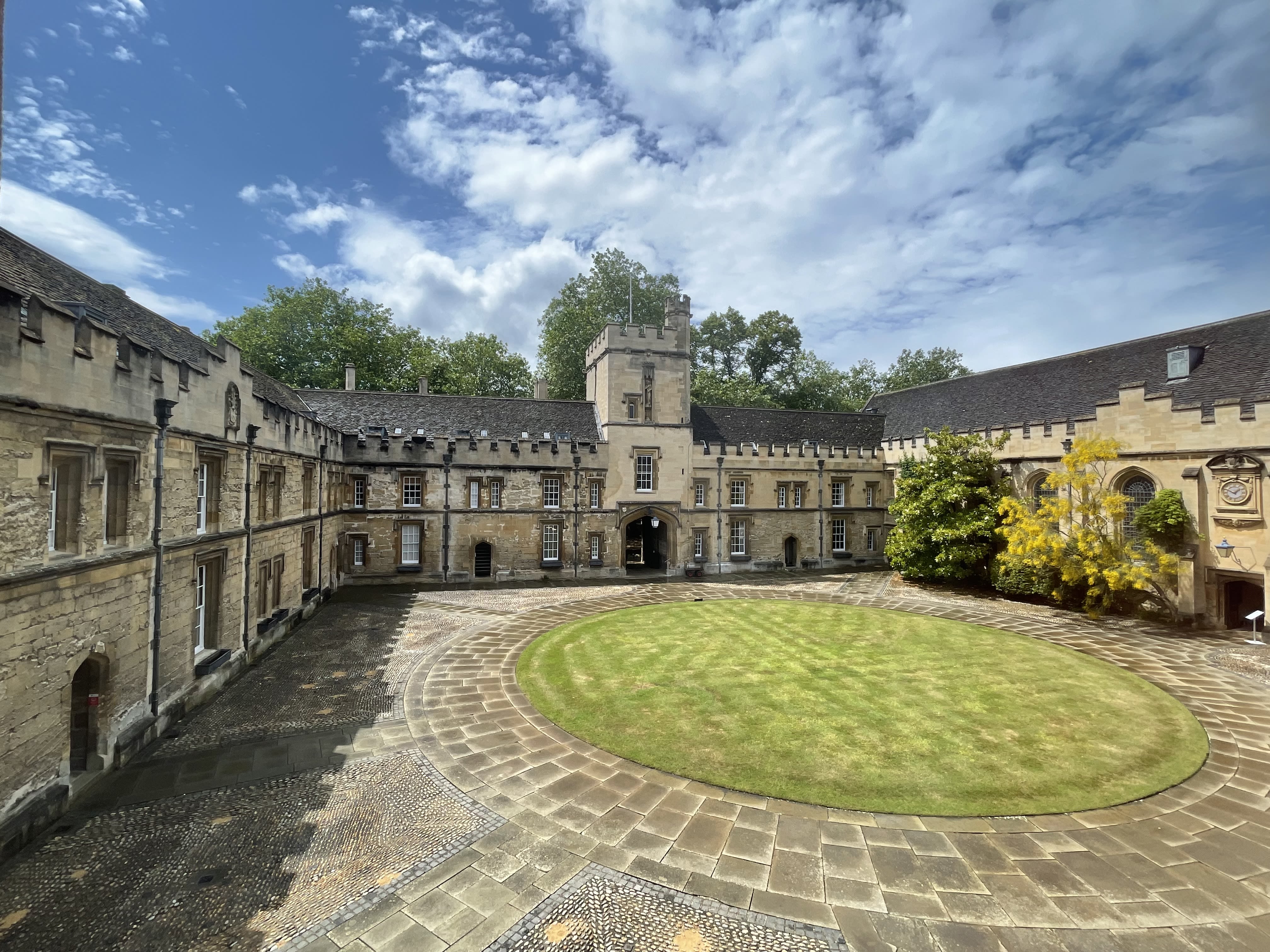Exploring the importance of early brain development

Mental health is not written in the stars – but some conditions can be determined even before birth and the origins of some vulnerabilities may lie in the first few months of life, says Professor Zoltán Molnár.
Everything you have ever heard about pregnancy and baby ‘education’ is basically true, explains Oxford’s professor of developmental neuroscience.
What diet you consume during pregnancy, how you feel, what a child experiences in their first months, even that cliché of playing them classical music – it all affects a child’s long-term brain health and development.
It is enough to make expectant mothers uncomfortable. The very genial Professor Molnár smiles.

Professor Zoltán Molnár
Professor Zoltán Molnár
‘In spite of all these complex interactions between an unfolding genetic program and the environment, most of the time, things will not go wrong, and we develop a perfectly normal brain. But you should not blame the mother,’ he says sympathetically.
‘Fathers can have responsibility as well… if a father is feeling stressed, that can have an impact on their sperm and that can have an impact on the child’s future mental health.’
It is little comfort. But, sitting at St John’s College, with a plastic skeleton looking over his shoulder, he explains the critical importance of the physical brain to mental health.

View of the Front Quad at St John's College, Oxford from Professor Molnár's teaching room
View of the Front Quad at St John's College, Oxford from Professor Molnár's teaching room
Brain development has been Professor Molnár’s passion since he qualified as a doctor in Hungary in the 1980s and started his specialisation in neurosurgery.
He says, ‘Brain development is fundamental. You are born with all the brain cells, called neurons, you will ever have.
'Most of the neurons are produced in utero, whereas some other elements of your brain, such as vasculature and supporting cells change during life.’
‘The first nine months of your life in utero are really crucial’
Professor Molnár explains. ‘We are born with all our brain cells. We carry them throughout our life. Our skin or gut cells regenerate every few weeks; we change the cells in our liver in a few months; the cells in our bones in a few years.
‘Cells in other organs divide and renew. However, brain cells don’t divide, and they don’t increase in their number. Like the eye and the nervous system, brain cells are born with you.’
Despite the importance of brain development, Professor Molnár says ruefully, the vast majority of neuro funding goes to brain degeneration, i.e., dementia or Parkinson’s disease.
Important though it is, those early experiences have a major impact on an individual’s entire life, they are relatively common and are under-researched.
The burden of developmental conditions becomes apparent, he says, when we compare the cumulative number of years lost due to ill-health, disability or early death.
It is not just conditions such as cerebral palsy or spina bifida which can be tracked back to pre-birth, Professor Molnár says:
‘One in three of us will have a mental health condition in our lifetimes and many may originate from pre-birth experiences and early life impacts.’
Neuro-developmental conditions are more common than one would think.
One in 200 in the population on average can develop childhood epilepsy, one in 100 can develop schizophrenia, one in 68 autism, one in 30 attention deficit hyperactivity disorder, one in 10 dyslexia.’
‘This is why I’m very interested in the fascinating process how the brain develops before and after birth. The experiences you have during early development are important in having a good life,’ says Professor Molnár.
After birth, we begin to develop the ability to make sense of the world around – colours, touch, pain, sounds, movements.
It is a period of intense development which is affected by the pre-birth experience. This is also the time when memory formation starts.
Video with thanks to Professor Mary Rutherford and Evelina London Children's Hospital (Guys' and St Thomas' NHS Foundation).
It has long been known that nutrition, radiation, infections, drugs, and alcohol abuse of the mother during pregnancy can affect an unborn child.
But Professor Molnár explains, mental health problems are far more prevalent than people realise.
He says casually, ‘One in 100, some estimates are even higher, people in the UK have some form of foetal alcohol syndrome (where the mother consumed alcohol while pregnant); it influences the brain development that can later manifest in difficulties with learning, challenging behaviours and mental health problems.
If this syndrome is caught early, he says, it can be corrected somewhat, but it can have a very significant impact on someone’s entire life, ‘They might find it difficult to get a job and live independently as an adult.
‘They often cannot really integrate into society. Some are in special institutions, and a shocking number are incarcerated. They are locked up in prisons but it was not their making.’
The developing nervous system is vulnerable to both adverse genetic and environmental conditions, but Professor Molnár is interested in their interactions; how the environment shapes the brain.
‘I study some of the earliest generated, but largely transient cells in our cerebral cortex called subplate.
These are the ‘scaffolding’ cells or temporary cells of the cerebral cortex, which help with brain development during in utero life and even after birth…’
Video with thanks to Marissa Mueller and Florina Szabo from the Molnar Laboratory, DPAG and James Bancroft and Ed Drydale from the Cellular Imaging Core of the Wellcome Centre for Human Genetics at the University of Oxford.
Video with thanks to Marissa Mueller and Florina Szabo from the Molnar Laboratory, DPAG and James Bancroft and Ed Drydale from the Cellular Imaging Core of the Wellcome Centre for Human Genetics at the University of Oxford.
The lowermost layer of the cerebral cortex contain the earliest generated neurons (red).
Most of these scaffold cells disappear during early postnatal period, but some survive to adulthood and maintain widespread connections in the adult brain.
‘How do they assist brain development?’ he asks.
‘How do they help or guide or co-exist with permanent elements of our nervous system? They peak before birth and then after the first year, there are hardly any left. It does seem they can cause damage if they remain or if they leave too early.’
Professor Molnár says earnestly:
‘There is so much we don’t know. I would like to understand the link between the number and distribution of these cells and certain neurological or psychiatric conditions.’
‘If the ‘scaffold’ is not there, the more permanent connections between different cells can also ‘go wrong’, he says.
Professor Molnár reveals one common impact of this, ‘One in ten people does not have 3D vision due to developmental alterations, although they may not even realise it.’
Professor Molnár talks with such engagement and interest.
It is easy to see why he was voted the students’ favourite professor at Lausanne University – even though, he says modestly, his French was appalling.

Lausanne, Switzerland
Lausanne, Switzerland
He also won Excellent Teaching Award at Oxford in 2010.
Listening to him, you could almost believe you understand neurology.
Although now a leading researcher in this area, Professor Molnár was not originally destined for academia.
Born in a small-town in central Hungary, Nagykőrös, at the height of the cold war, his parents – as with many Hungarian parents – were keen for their children to be medical doctors or lawyers.
Although they were an artist and a teacher of history of art, in the Molnárs’ case, they were relieved when all three decided to become doctors – and so Zoltán and his two brothers, Elek and Béla, went to Albert Szent-Györgyi Medical University at Szeged.

Zoltán, Elek and Béla Molnár
Zoltán, Elek and Béla Molnár
The newly qualified doctor Molnár had to decide between research and medicine. Although he was always interested in research and worked with Professor György Benedek at the Physiology Department throughout his studies, he recalls, he was still keen to go into neurosurgery.
It was a fascinating area and he ‘loved it’.
Although surgery was done by the senior staff, he was able to help with some minor procedures at the trauma department.
Although very much enjoying the work, the young doctor applied for a Hungarian Academy - George Soros scholarship to come to Oxford to study for one year. He says:
‘I applied for this scholarship before I got into the residency program; I didn’t expect to get it’
Although he was top of his year at the university, he ‘had to take a language test and have an interview in the British Embassy in Budapest’.
He had been learning English since he was 12 and Russian since the age of 6, but he was nervous at the interview which was conducted by a small group of Oxford academics, including Nicholas Kürti and László Solymár.
It was to his surprise that young Dr Molnár was awarded the scholarship and was persuaded by his mentors to take up the offer.
Aside from two years in Lausanne and some shorter fellowships in Kyoto and Davis, he has remained in Oxford ever since.
Initially, Professor Molnár was attached to Hertford College.
After arriving he decided to study for a doctorate alongside his work. After paying for his tuition he had just £300 a month on which to live.
Once he had done his DPhil, Dr Molnár won a junior research fellowship at Merton, where he met his future wife, Nadia who came from Lausanne, Switzerland and was studying for a doctorate in History and whose room in St Alban’s Quad in the college was previously occupied by a certain Irene Tracey (now Oxford’s Vice-Chancellor).
‘I remember the phone kept ringing for Irene several months after she left for Boston.’

Merton College, Oxford
Merton College, Oxford
It was after meeting Nadia that he began taking classes in French – although, as it turned out, they only remained in Switzerland for three years, before returning to Oxford with their two sons, Matyas and Thomas.
Professor Molnár explains some mental health conditions originate from the time of early development but may not manifest until after puberty and may lie dormant in brains until later years. He says:
‘Our brains show great individual variations; they can be very different; they cope with interactions with the World and other brains in very different ways. The nervous system is so flexible’
The young brain is so different from an adult brain.
Although, he says, ‘when I compared the spread of nerve activity in a slice of cerebral cortex from a newborn mouse with a 4 days old I was shocked to see in these experiments how much slower the information spread in the younger brain and how much longer the activity pattern stayed in the young tissue.
‘This has great importance in learning and memory, there are different learning rules in younger brains.
Later it is much more difficult to associate things. I mentioned 3D vision; this has to get established shortly after birth, later there are more limited mechanisms to compensate.’
What are the breakthroughs that Professor Molnár is hoping to see coming up?
‘I would like to understand the link between the symptoms of illnesses such as schizophrenia, autism or epilepsy and the remnant ‘scaffold’ cells that has not been cleared away,’ Professor Molnár comes back quickly.
‘How do these extra cells impact on brain functions? What cells do they contact and what hormones or neurotransmitters activate these extra cells that can trigger pathological conditions? This should be in the next couple of years…’
Professor Molnár is also passionate about teaching and he is a tutor and lecturer.
‘I do about 150 contact hours a year; this includes lectures, practicals and tutorials – it is quite a heavy load. The quality of students is superb. It’s a pleasure to spend time with them.’
‘I am also the founding senior member of the “Cortex Club” that has an important role in graduate neuroscience community.
I also interact with students and colleagues through the “Oxford History of Medical Sciences Project” that I initiated with Richard Boyd and Damion Young in 2010.’
Professor Molnár speaks to experts form a variety of disciplines on the importance of Thomas Willis
Although Oxford is home, Professor Molnár still returns to Hungary to give lectures and help with grant evaluations or with research collaborations, when he can.
During 2023’s Mental Health Awareness Week he gave interviews to Európarádio and KarcFM in Budapest, and three lectures at University of Debrecen.
Additionally, he gave an interview to NeurotechEU, where he had represented the University of Oxford until the UK's exit from the European Union.
He also published a book Body, Brain, Behavior which he has translated into Hungarian this year.
With all his research work and teaching undergraduate and graduate students, he has little time.
Having said that, he proudly talks about his role as honorary treasurer of the University’s Lawn Tennis Club, given away by an entire wall covered in antique wooden tennis racquets.
A keen player, he says, he plays three or four times a week – not with the displayed racquets, though.
‘Tennis is very good for the brain,’ says Professor Molnár.
‘Dancing is the best though… something to do with movements, responding to and interacting with another person and the music. But tennis is nearly as good.’
So, there are things you can do, to help your brain, even as an older person.
Professor Molnár is a keen believer in never giving up in neurological or mental health conditions.
If much about brain health is based on early childhood, what about Einstein? The fashion when he was a baby was for putting children in prams and leaving them outside on their own, with little stimulation.
‘Yes,’ says Professor Molnár amused.
‘Having said all that, Einstein had an unusual childhood and Newton was a very premature baby and look at what key contributions they both made to science’


